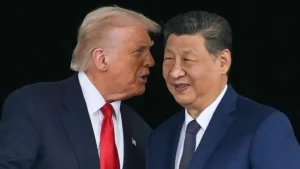THE STORY OF CHINESE DECEPTION “無中生有” Wú zhōng shēng yǒu Create something from nothing
This strategy forms part of the famous ‘Thirty Six Stratagems’ of ancient China, which are a set of guidelines formulated to win over any enemy by using any means possible. The abovementioned strategy clearly speaks of creating an illusionin the minds of the adversary about possessingsomething (technology, equipment, capability etc.) which one does not actually have,in order to fool the enemy. A classic wartime illusion is to make it appear that one hasbetter, largerand stronger forces than actual.This simple strategy, if used efficiently, when amplified by the ‘Fog of War’ can create havoc in the enemy camp, much like the attack on Yong Qiu by LinghuChao (Qin dynasty) in 756 BC, wherein the army of Yong Qiuwas running out of arrows and so the defending General, Chang Shun ordered dummy soldiers made of straw to be placed at the various places in the fort. Hence, when Chao fired thousands of arrows at these soldiers, the Yong Qiu forces gratefully collected them thus replenishing their supplies.
The Chinese have been heavily influenced by these ancient strategies (of the Art of War, the 36 Stratagems) and have strived to keep them relevant even today. This is evident by the fact that most of the speeches by Chinese President Xi include heavy use of Chinese idioms and old sayings. Also, the Art of War by Sun Tzu is one of the most widely followed and translated document on military strategy. Most of the strategies in the stratagems involve deception and deceit and is something which the Chinese have been using extensively. The present day “Three Warfare” strategy of PLA, (Public opinion warfare, Psychological warfare and Legal warfare), is an official political and information non-warfare strategy (also heavily influenced by these ancient texts) which relies heavily on propaganda, deception and deceit byemploying party controlled media orother methods of showcasing China’s growing influence in the global perspective especially in the field of tech and military modernisations.
The much talked about ‘Cognitive Domain Ops’, employed extensively by the PLA,also draws inspiration from these ancient strategies of deception/ deceit and playing with the morale of not only the enemy forces but deceive their own population by creating a false perception of China’s development and capabilities. The censorship and control of the media,by the CCP and PLA, adds to its strength in controlling and propagating the agenda and does not allow even the slightest amount of criticism and reality check of the inputs floated by the Chinese media.
Although, the durability of Chinese made products do find their share of criticism in many countries in terms of reliability and longevity, it is because of the media censorship that the reality of these reports/ developments either does not come out at all or are later reported by other international media reports/ research papers.This article aims to highlight the various recent instances wherein the propaganda tactics employed by the PLA were clearly called out and left China embarrassed/ red faced.Thearticle will primarily focus on the reports related to the status of Chinesedefense exports and various recent media reports challenging the veracity of the Chinese claims and the various questions raised regarding the quality, durability and overall performance of military equipment.
The Chinese Weather Balloon Incident.
Until one has been living under a rock or in a cave for the past year, the Chinese weather balloon incident needs no introduction. The balloon which was touted as some advanced Chinese recce equipment was the topic of discussion and made international headlines for almost entire first half of 2023. Various theories regarding the nature of its mission and the surveillance capability and the extent of data which it might have collected while effortlessly floating over the American airspace ran everyone’s imagination wild. However, ever since the balloon was shot down and its contents were recovered no concrete evidence of it being a sophisticated surveillance and recceequipment has been found. Infact, Pentagon has said that the Chinese Spy balloon ‘did not collect’ any information while flying over the United States1. Additionally, the three other unidentified objects that were destroyed over Alaska, Canada and Michigan, by the USAF, in the aftermath of the Feb incident, were later claimed to be ‘benign’ by the US2. According to White House spokesman John Kirby, “the objects may be ‘tied to commercial or research entities and therefore benign”.
Sharp decline in Chinese arms exports due defective quality.
Numerous reports have surfaced regarding the trouble faced by the countries who have imported Chinese military equipmentin the recent years and have led to a decline in the Chinese defense exports. According to a report by the Stockholm International Peace Research Institute (SIPRI),from 2016 to 2020, China’s arms shipments fell by 7.8 percent,as compared to the previous five year data. China’s global market also shrunk from 5.6 % to 5.2 % as the Chinese armaments failed to perform as promised3. According to Alexander Vuving4, professor at the Daniel K Inouye Asia-Pacific Center for Security Studies, “China-made weapons are not just technologically inferior, they also remain untested in the battlefield.”
China exports its military equipment to over 53 nations, most of which are small markets for big arms suppliers such as the US. Hence, countries like Pakistan, Myanmar, Bangladesh and African and Middle Eastern countries are major importers. However, major concerns have cropped up about the quality and durability as well as the certification standards of these products, despite Chinese claims, when compared to the West5. For example, in Nov 2022, Global Defense Corp, a defence and aerospace industry news site reported that the Burmese military grounded its JF-17 aircraft due to serious structural and engine problems which are yet to be fixed and currently 11 JF-17 aircraft have been declared “unfit for operations”. Numerous reports have emerged from various countries about poor quality, degraded performance and unavailability of spares which has become a cause of concern for China which otherwise claims of impeccable performance by its equipment. An equipment-wise failure report of various countries using Chinese military equipment is compiled below:
Aircraft
(a) J-20. China’s J-20, the fifth-generation fighter jet, renowned for its advanced stealth capabilities which are largely attributed to its radar-absorbing materials (RAM). These materials are designed to minimize the aircraft’s radar cross-section, making it difficult for enemy radar systems to detect and track the fighter. However, the harsh environmental conditions of the Tibetan Plateau seem to be taking a toll on these crucial stealth components.Variousreports6 suggest that the RAM coatings on the
J-20 developed cracks due to the combination of low oxygen levels, extreme temperatures and other environmental factors, after just one sortie. China’s
J-20 stealth fighters, were hailed as the vanguard of its air force, however, these cracks in the stealthy armour as well as the credibility of Chinese claims not only reveal the complexities of deploying cutting-edge technology in a challenging environmentlike TARbut also pose serious questions on China’s claims and actual capability ofdeveloping an indigenousstealth technology.
(b) JF-17 Thunder.In November 2022, the Burmese military grounded its fleet of JF-17 fighter jets due to serious structural and engine problems. Eleven aircraft were declared “unfit for operations,” raising concerns about the quality of this Chinese-made fighter. Pakistan currently possesses over 100 JF-17 Block 1 & 2 fighters out of which roughly40 are not fly-worthy. Some of the other reported issues7 are as follows:-
(i) The indigenous Link-17 data-link of JF-17 is not compatible with the PAF’s American-built F-16 fighter jets’ Link-16 and hence is unable to give the aircraft true interoperability. There are issues with the data transfer rates with Link-17 data-link as well8.
(ii) In addition, the critical elements of the JF-17 avionics, the KLJ-7 Al radar and Weapon Mission Management Computer (WMMC), have been facing a host of problems.While the KLJ-7 radar have reportedly faced several operational and maintenance problems, the weapon mission management computer (WMMC) is also reported to havelimited capacity and showed a high rate of failure of a number of its modules, including the main computer module.Themilitary junta ruling Myanmar found that the Chinese-made radar on its JF-17 aircraft has poor accuracy, and the aircraft itself lacks beyond-visual-range missile and airborne interception radar9.
(iii) Some of the other unremarkable flaws of JF-17 include low endurance and poor accuracy of its REK (Range Extension Kit) bombs. It was even named as the “PAF JF-17 Blunder” after the crash during a training mission on 15 Sept 2020.
UAVs / UCAVs
(c) CH-4. In 2016,Jordan had bought six CH-4 drones which are claimed to be broadly similar to early-model of Predators.However by Nov 2018, the Jordanian Air Force disclosed that it was looking to retire them, as the performance of these UAVs is unsatisfactory. After their decommissioning in early 2019, the CH-4Bs were put up for sale andthe most plausible scenario is that they were sold to Saudi Arabia, which already operates a large fleet of CH-4Bs (unlike the LNA)10.Jordan preferred to dispose of its CH-4Bs – in turn leaving no MALE UAVs in service with the country – rather than continuing to operate the type could indicate that their issues were simply too severe to resolve. Similarly,Saudi Arabia appears to have run into issues in operating its CH-4Bs as well.Common problems encountered reportedly include a lack of servicing and maintenance documentation and no spare part/ inventory ordering system. In Iraq, with eight of its 20 CH-4Bs crashing within a timespan of just a few years,the twelve remainingCH-4Bs are currently languishing in a hangar due to a lack of spare parts. According to a US-led coalition report in 2019, Iraq has more than 10 CH-4s but only onewas fully mission capable because of maintenance problems. It was subsequently reported that they had all been grounded owing to contractual problems11.Algeria, yet another operator of the CH-4B, lost three CH-4Bs to crashes in a matter of months. The first accident took place in 2013 near Algeria’s Tindouf airbase; second near the Ain Oussera Airbase; and third near Bir Rogaa airbase12.
(d) Wing Loong. Pakistaninducted three Wing Loong II armed drones, designed by CATIC, in Jan 2021. However, these had to begrounded due to crippling effects within days of their induction. The unserviceability reported13 include issues with EO/IR cameras, failure of rear fuel pump (wherein the spares supplied by the Chinese firm were a mismatch!) and failure of SATCOM during launch and take-off stages.
Air Defence Systems
(e) HQ-16. Pakistan acquired the HQ-16 medium range SAMs in 2017. However as many as 477 defects have emerged in the system since its inception which has been a major blow to Pakistan’s air defence. Even after a Chinese company deployed its team of technicians, in 2021, to address the issues and repair the defects, the problems were reported to be “too extensive to be fully addressed”14. Similarly, Myanmar too experienced malfunctions with its HQ-16 AD system, with three out of nine systems remaining non-functional due technical defects.
(j) FN-16 MANPADS.The FN-16 MANPADS form a key part of Pakistan’s air defence system. However, the system’s failures have raised concerns about Pakistan’s ability to defend itself against air attacks14as asignificant number of FN-16 systems (approx. 850) have been found to be non-functional with defective surface-to-air night aiming and battleground signalling systemas well asissues of premature wear and tear etc.Additionally, Pakistan also reported that the on-board imaging device of the FM90 (N) missile system had a defective infrared sensor (IR17) system and SR-60 radars. As a result, the missile system was unable to lock onto targets. As a result, the IR-17 sensors had to be discarded completely15.
Apart from the reports highlighted above, there are numerous other instances (of various other Chinese companies) wherein China’s defense industry has come under immense scrutiny and criticism after exporting malfunctioning or defective equipment to the countries – leaving them helpless and defenceless and drained of their military budgets. The quality, durability and overall performance of manufacturing by Chinese companieshave been found much below the desired/claimed standards. These instances clearly highlight the grim reality of the Chinese claims of becoming a Global manufacturing hub and its ability to compete with other global powers.
Although China attracts its customers (countries) for military equipment with lucrative pricing and the promise of other investments (like OBOR/ CPEC etc.), the Chinese suppliers have time and again demonstrated little accountability for maintenance or repair which has subsequently led to these countries seeking help from other third world countries as was evident when the Myanmar military had to request Pakistani technicians to resolve the technical issues with JF-17.Pakistan too had to approach Russia for the supply of RD-93 engines for its JF-17, by passing China16.
Apart from the fact that China has time and again been accused of copying designs, reverse-engineering tech and exaggerating the capabilities of its equipment, some probable reasons/ factors contributing to these equipment failuresincludesChina’s rapid military modernization program may hasled toshorter timelines leading to certain shortcuts in quality control and testing procedures. Another reason is that China often lacks transparency about its military capabilities and development programs, making it difficult to assess the truecapability, durability and reliability of its weapons.China’sattempts of reverse engineering foreign technologies,often leads to design flaws and inconsistencies in performance, as was the case with J-20 which was initially conceptualised similar to the US-F-22 Raptor, but had to incorporate canards in its airframe to cater for the aerodynamic inconsistencies. Additionally, in order to offer competitive prices, China mostly prioritizes cost-cutting over quality in its weapons production but generally involve higher after sales/ serviceability costs or poor maintenance support.
Among the previously mentioned Thirty-six stratagems, the twenty-ninth stratagem (樹上開花, Shù shàng kāi huā, Decking the tree with fake flowers) talks about pretending to be more than one’s capabilities.While there is no doubt that China has made significant progress in its military capabilities over the decade, the discreet development of its military tech, the exaggerated claims of their capabilities and the numerous instances/reported failures of its equipment raise serious concerns about their durability for the long term and reliabilityduring harsh wartime scenarios and it seems that Chinese claims of the capabilities of its indigenous equipment is heavily inspired by this age old saying. At present, the biggest challenge for China is to address these critical issues in order to maintain its self-proclaimed position as a major arms exporter and for other countries to have confidence in its weapons systems. The extent to which China will be able to salvage its lost reputation in the near future remains unclear. Another lesson is for the countries planning to buy Chinese equipment in future as well as for those who regularly monitor its progress to not to jump to conclusions and not be fooled by the exaggerated claims by Chinese companies.
Bibliography
1. https://www.bbc.com/news/world-us-canada-66062562.
2. https://www.bbc.com/news/world-us-canada-64644845
7. https://www.sps-aviation.com/story/?id=3248&h=The-UnReliable-JF-17
8. https://www.eurasiantimes.com/pakistans-jf-17-fighter-jet-an-absolute-failure-could-opt-for-j-10s-instead-greek-media/
9. https://www.sps-aviation.com/story/?id=3248&h=The-UnReliable-JF-17
10. https://www.oryxspioenkop.com/2022/01/operational-failure-ch-4bs-short-lived.html
11. https://www.janes.com/defence-news/news-detail/iraq-returns-ch-4-uav-to-service
14. https://theprint.in/world/china-unable-to-supply-spare-parts-for-missiles-it-sold-to-pakistan/1057526/
15. https://www.aninews.in/news/world/asia/pakistan-air-defence-system-put-in-danger-by-china20210720211101/ 16. https://www.sps-aviation.com/story/?id=3248&h=The-UnReliable-JF-17













